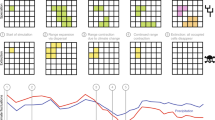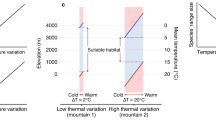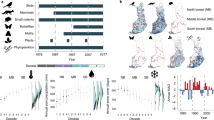Abstract
Forecasts of species range shifts as a result of climate change are essential, because invasions by exotic species shape biodiversity and therefore ecosystem functions and services. Ecologists have focused on propagule pressure (for example, the number of individuals and invasion events), the characteristics of an invading species, and its new abiotic and biotic environment to predict the likelihood of range expansion and invasion. Here, we emphasize the role of photoperiodic response on the range expansion of species. Unlike temperature, the latitudinal gradient of seasonal changes in day length is a stable, abiotic environmental factor that does not change with local or global climate. Predicting range expansions across latitudes and the subsequent consequences for native communities requires a more comprehensive understanding of how species use day length to coordinate seasonal growth, reproduction, physiology and synchronization of life cycles with interacting individuals and species.
This is a preview of subscription content, access via your institution
Access options
Subscribe to this journal
Receive 12 print issues and online access
$209.00 per year
only $17.42 per issue
Buy this article
- Purchase on Springer Link
- Instant access to full article PDF
Prices may be subject to local taxes which are calculated during checkout


Similar content being viewed by others
References
Křivánek, M., Pyšek, P. & Jarošík, V. Planting history and propagule pressure as predictors of invasion by woody species in a temperate region. Conserv. Biol. 20, 1487–1498 (2006).
Webster, C. R., Jenkins, M. A. & Jose, S. Woody invaders and the challenges they pose to forest ecosystems in the eastern United States. J. Forest. 104, 366–374 (2006).
Feehan, J., Harley, M. & van Minnen, J. Climate change in Europe: impact on terrestrial ecosystems and bio-diversity. Agron. Sust. Dev. 29, 409–421 (2009).
Walther, G-R. et al. Alien species in a warmer world: risks and opportunities. Trends Ecol. Evol. 24, 686–693 (2009).
Parmesan, C. & Yohe, G. A globally coherent fingerprint of climate change impacts across natural systems. Nature 421, 37–42 (2003).
Thuiller, W., Lavorel, S., Araújo, M. B., Sykes, M. T. & Prentice, I. C. Climate change threats to plant diversity in Europe. Proc. Natl Acad. Sci. USA 102, 8245–8250 (2005).
Chen, I. C., Hill, J. K., Ohlemüller, R., Roy, D. B. & Thomas, C. D. Rapid range shifts of species associated with high levels of climate warming. Science 333, 1024–1026 (2011).
Tewksbury, J. J., Sheldon, K. S. & Ettinger, A. K. Moving farther and faster. Nature Clim. Change 1, 396–397
Davis, M. A. et al. Don't judge species on their origins. Nature 474, 153–154 (2011).
Sala, O. E. et al. Global biodiversity scenarios for the year 2100. Science 287, 1770–1774 (2000).
McKinney, M. L. Urbanization as a major cause of biotic homogenization. Biol. Conserv. 127, 247–260 (2006).
Hulme, P. E., Pyšek, P., Nentwig, W. & Vilà, M. Will threat of biological invasions unite the European Union? Science 324, 40–41 (2009).
Pimentel, D., Lach, L., Zuniga, R. & Morrison, D. Environmental and economic costs of nonindegenous species in the United States. BioScience 50, 53–65 (2000).
Elith, J. et al. Novel methods improve prediction of species' distributions from occurrence data. Ecography 29, 129–151 (2006).
Thuiller, W. et al. Predicting global change impacts on plant species' distributions: Future challenges. Perspect. Plant Ecol. Evol. Syst. 9, 137–152 (2008).
Simberloff, D. The role of propagule pressure in biological invasions. Annu. Rev. Ecol. Evol. Syst. 40, 81–102 (2009).
Ehrenfeld, J. G. Ecosystem consequences of biological invasions. Annu. Rev. Ecol. Syst. 41, 59–80 (2010).
Gilman, S. E., Urban, M. C., Tewksbury, J., Gilchrist, G. W. & Holt, R. D. A framework for community interactions under climate change. Trends Ecol. Evol. 25, 325–331 (2010).
Lavergne, S., Mouquet, N., Thuiller, W. & Ronce, O. Biodiversity and climate change: Integrating evolutionary and ecological responses of species and communities. Annu. Rev. Ecol. Evol. Syst. 41, 321–350 (2010).
Gevrey, M. & Worner, S. P. Prediction of global distribution of insect pest species in relation to climate by using an ecological informatics method. J. Ecol. Entomol. 99, 979–986 (2006).
Nelson, R. J., Denlinger, D. L. & Somers, D. E. (eds) Photoperiodism, the Biological Calendar (Oxford Univ. Press, 2010).
Simpson, G. G. & Dean, C. Arabidopsis, the Rosetta stone of flowering time? Science 296, 285–289 (2002).
Sakai, A. & Larcher, W. Frost Survival in Plants: Responses and Adaptation to Freezing Stress (Springer-Verlag, 1987).
Körner, C. & Basler, D. Phenology under global warming. Science 327, 1461–1462 (2010).
Bradshaw, W. E. & Holzapfel, C. M. Evolution of animal photoperiodism. Annu. Rev. Ecol. Evol. Syst. 38, 1–25 (2007).
Bradshaw, W. E. & Holzapfel, C. M. Light, time, and the physiology of biotic response to rapid climate change in animals. Annu. Rev. Physiol. 72, 147–166 (2010).
Putterill, J., Laurie, R. & Macknight, R. It's time to flower: The genetic control of flowering time. BioEssays 26, 363–373 (2004).
Berthold, P., Helbig, A. J., Mohr, G. & Querner, U. Rapid microevolution of migratory behaviour in a wild bird species. Nature 360, 668–670 (1992).
Hard, J. J., Bradshaw, W. E. & Holzapfel, C. M. The genetic basis of photoperiodism and its evolutionary divergence among populations of the pitcher-plant mosquito, Wyeomyia smithii. Am. Nat. 142, 457–473 (1993).
Bradshaw, W. E. & Holzapfel, C. M. Genetic shift in photoperiodic response correlated with global warming. Proc. Natl Acad. Sci. USA 98, 14509–14511 (2001).
Réale, D., Berteaux, D., McAdam, A. G. & Boutin, S. Lifetime selection on heritable life-history traits in a natural population of red squirrels. Evolution 57, 2416–2423 (2003).
Nussey, D. H., Postma, E., Gienapp, P. & Visser, M. E. Selection on heritable phenotypic plasticity in a wild bird population. Science 310, 304–306 (2005).
Schmidt, P. S., Matzkin, L. M., Ippolity, M. & Eanes, W. F. Geographic variation in diapause incidence, life-history traits, and climatic adaptation in Drosophila melanogaster. Evolution 59, 2616–2625 (2005).
Bradshaw, W. E. & Holzapfel, C. M. Evolutionary response to rapid climate change. Science 312, 1477–1478 (2006).
Tauber, E. et al. Natural selection favors a newly derived timeless allele in Drosophila melanogaster. Science 316, 1895–1898 (2007).
Bradshaw, W. E. & Holzapfel, C. M. Genetic response to rapid climate change: It's seasonal timing that matters. Mol. Ecol. 17, 157–166 (2008).
Bradshaw, W. E., Quebodeaux, M. C. & Holzapfel, C. M. Ciracadian rhythmicity and photoperiodism in the pitcher-plant mosquito: Adaptive response to the photic environment or correlated response to the seasonal environment? Am. Nat. 161, 735–378 (2003).
Roff, D. A. The evolution of genetic correlations: An analysis of patterns. Evolution 50, 1392–1403
Etterson, J. R. & Shaw, R. G. Constrain to adaptive evolution in response to global warming. Science 294, 151–154 (2001).
Ahlholm, J. et al. Micro-fungi and invertebrate herbivores on birch trees: Fungal mediated plant-herbivore interactions or responses to host quality? Ecol. Lett. 5, 648–655 (2002).
Baer, C. F. & Lynch, M. Correlated evolution of life-history with size at maturity in Daphnia pulicaria: Patterns within and between populations. Genet. Res. 81, 123–132 (2003).
Donohue, K. et al. Environmental and genetic influences on the germination of Arabidopsis thaliana in the field. Evolution 59, 740–757 (2005).
Bradshaw, W. E., Emerson, K. J. & Holzapfel, C. M. Genetic correlations and the evolution of photoperiodic time measurement within a local population of the pitcher-plant mosquito, Wyeomyia smithii. Heredity http://dx.doi.org/10.1038/hdy.2011.108 (2011).
Dewar, R. C. & Watt, A. D. Predicting changes in the synchrony of larval emergence and budburst under climatic warming. Oecologia 89, 557–559 (1992).
Visser, M. E., van Noordwijk, A. J., Tinbergen, J. M. & Lessells, C. M. Warmer springs lead to mistimed reproduction in great tits (Parus major). Proc. R. Soc. Lond. B. 265, 1867–1870 (1998).
Edwards, M. & Richardson, A. J. Impact of climate change on marine pelagic phenology and trophic mismatch. Nature 430, 881–884 (2004).
Winder, M. & Schindler, D. E. Climate change uncouples trophic interactions in an aquatic ecosystem. Ecology 85, 2100–2106 (2004).
Both, C., Bouwhuis, S., Lessells, C. M. & Visser, M. E. Climate change and population declines in a long-distance migratory bird. Nature 441, 81–83 (2006).
Thomas, C. D. et al. Ecological and evolutionary processes at expending range margins. Nature 411, 577–581 (2001).
Franks, S. J., Sim, S. & Weis, A. E. Rapid evolution of flowering time by an annual plant in response to a climate fluctuation. Proc. Natl Acad. Sci. USA 104, 1278–1282 (2007).
Niemelä, P. & Mattson, W. J. Invasion of North American forests by European phytophagous insects. Legacy of the European crucible? BioScience 46, 741–753 (1996).
Lockwood, J. L., Cassey, P. & Blackburn, T. The role of propagule pressure in explaining species invasions. Trends Ecol. Evol. 20, 223–228 (2005).
Maron, J. L., Vilà, M., Bommarco, R., Elmendorf, S. & Beardsley, P. Rapid evolution of an invasive plant. Ecol. Monogr. 74, 261–280 (2004).
Climate Change 2007: The Physical Science Basis (eds Solomon, S. et al.) (Cambridge Univ. Press, 2007).
IPCC Climate Change 2007: Impacts, Adaptations and Vulnerability (eds Parry, M. L., Canziani, O. F., Palutikof, J. P., van der Linden, P. J. & Hanson, C. E.) (Cambridge Univ. Press, 2007).
Tilman, D. Community invasibility, recruitment limitation, and grassland biodiversity. Ecology 78, 81–92 (1997).
Butchart, S. H. M. et al. Global biodiversity: Indicators of recent declines. Science 328, 1164–1168 (2010).
Dahl, E. On the relationship between summer temperature and the distribution of alpine vascular plants in the lowlands of Fennoscandinavia. Oikos 3, 22–52 (1951).
Wareing, P. Photoperiodism in woody plants. Annu. Rev. Plant Physiol. 7, 191–214 (1956).
Campbell, R. K. & Sorensen, F. C. Cold-acclimation in seedling Douglas-fir related to phenology and provenance. Ecology 54, 1148–1151 (1973).
Repo, T., Zhang, G., Ryyppö, A., Rikala, R. & Vuorinen, M. The relation between growth cessation and frost hardening in Scots pines of different origins. Trees 14, 456–464 (2000).
Savolainen, O., Pyhäjärvi, T. & Knürr, T. Gene flow and local adaptation in trees. Annu. Rev. Ecol. Evol. Syst. 38, 595–619 (2007).
Bigras, F. & D'Aoust, A. L. Influence of photoperiod on shoot and root frost tolerance and bud phenology of white spruce seedlings (Picea glauca). Can. J. Forest Res. 23, 219–228 (1993).
Heide, O. M. Temperature rather than photoperiod controls growth cessation and dormancy in Sorbus species. J. Exp. Bot. http://dx.doi.org/10.1093/jxb/err213 (2011).
Taulavuori, E., Taulavuori, K., Niinimaa, A. & Laine, K. Effect of ecotype and latitude on growth, frost hardiness, and oxidative stress of south to north transplanted Scots pine seedlings. Int. J. Forest Res. 2010, 162084 (2010).
Taulavuori, K., Sarala, M. & Taulavuori, E. Growth responses of trees to Arctic light environment. Prog. Bot. 71, 157–168 (2010).
Sarala, M., Taulavuori, E., Karhu, J., Laine, K. & Taulavuori, K. Growth and pigmentation of various species under blue light depletion. Boreal Environ. Res. 16, 381–394 (2011).
Peltonen-Sainio, P., Jauhiainen, L., Hakala, K. & Ojanen, H. Climate change and prolongation of growing season: Changes in regional potential for field crop production in Finland. Agr. Food Sci. 18, 171–190 (2009).
Olesen, J. E. et al. Impacts and adaptation of European crop production systems to climate change. Eur. J. Agron. 34, 96–112 (2011).
Trnka, M. et al. Agroclimatic conditions in Europe under climate change. Glob. Change Biol. 17, 2298–2318 (2011).
Vänninen, I. et al. Recorded and potential alien invertebrate pests in Finnish agriculture and horticulture. Agr. Food Sci. 20, 96–114 (2011).
Schumann, G. L. Plant Diseases: Their Biology and Social Impact (APS Press, 1998).
Acknowledgements
We thank S. Faeth and I. Saloniemi for invaluable comments on the manuscript and H. Ojanen for preparing the world climate map. This study was funded by the Academy of Finland (project number 137909).
Author information
Authors and Affiliations
Contributions
K.S. led the creation and writing of the paper with inputs from all authors. All authors participated in the literature survey of their expertise (K.S.: climate change, and general ecology and evolution; K.T.: photoperiodism; T.H.: climate change, weeds; P.E.G.: crop species; C.E.H.: crop species; I.V.: pests; A.N.: pests; M.H.: pathogens).
Corresponding author
Ethics declarations
Competing interests
The authors declare no competing financial interests.
Rights and permissions
About this article
Cite this article
Saikkonen, K., Taulavuori, K., Hyvönen, T. et al. Climate change-driven species' range shifts filtered by photoperiodism. Nature Clim Change 2, 239–242 (2012). https://doi.org/10.1038/nclimate1430
Published:
Issue Date:
DOI: https://doi.org/10.1038/nclimate1430
This article is cited by
-
Clock-talk: have we forgotten about geographic variation?
Journal of Comparative Physiology A (2023)
-
Unusual early peaks of airborne ragweed (Ambrosia L.) pollen in the Pannonian Biogeographical Region
International Journal of Biometeorology (2022)
-
Light and energetics at seasonal extremes limit poleward range shifts
Nature Climate Change (2021)
-
Tracking biological footprints of climate change using flowering phenology of the geophytes: Pancratium tenuifolium and Scadoxus multiflorus
International Journal of Biometeorology (2021)
-
Winter temperatures predominate in spring phenological responses to warming
Nature Climate Change (2020)



